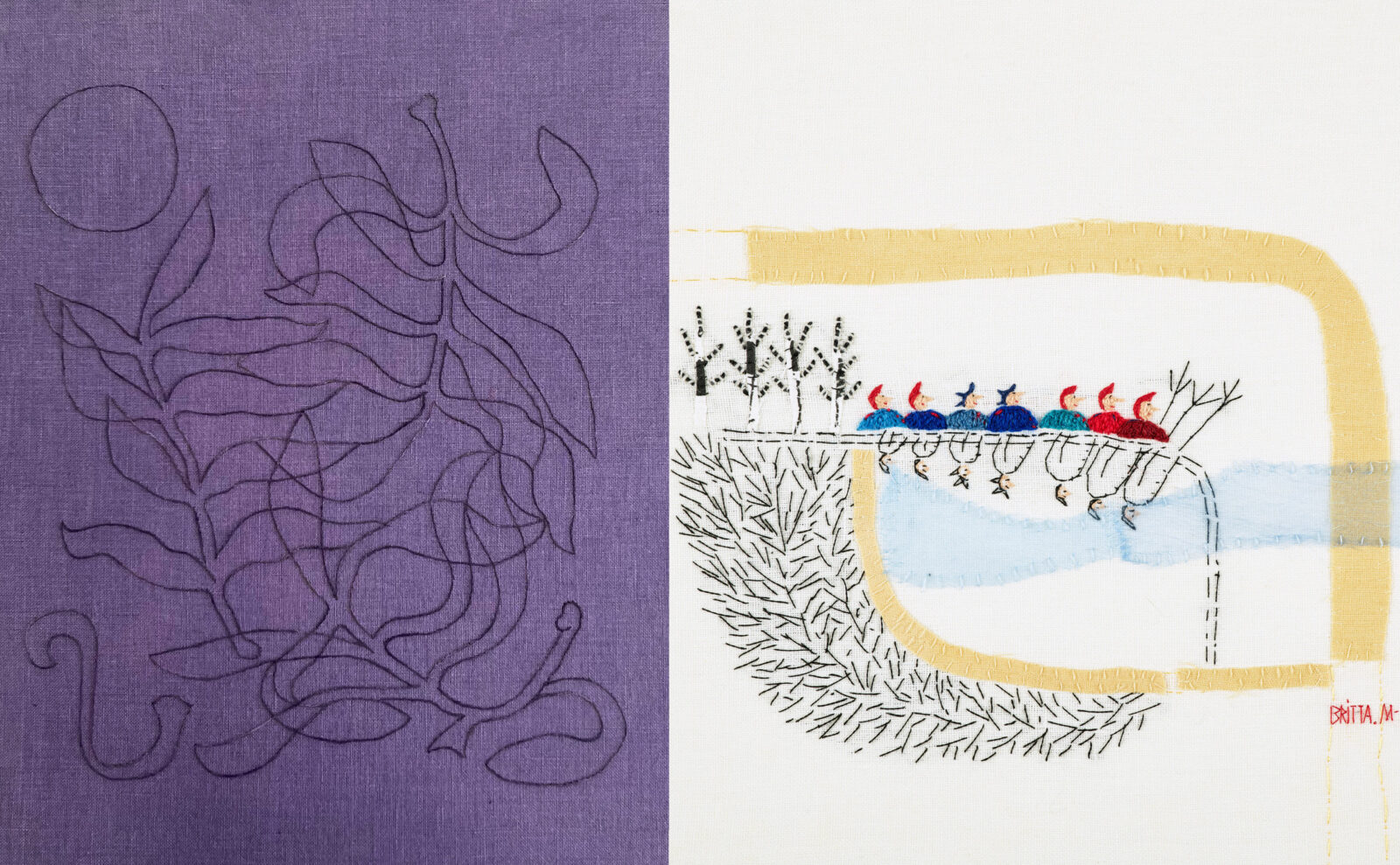Exhibition opening 14 August, from 17.00-20.00
Å rakne / To fray
Several works in Ask Bjørlo’s new series of embroideries include glittering plastic paillettes. In Refleksjon 1 (2025), they are bright green and sewn in lines which form a square-shaped patch. The linen fabric which comprises its background is dyed by hand using plant pigment—in this case a light and mushy blue, bordering on turquoise. Almost magically, the synthetic pieces glimmer when one moves around it, as the light hits differently. In this green motion, I see nature. I see the chlorophyll of the trees and lichen I’ve been surrounded by on the mountain over summer, and I am reminded of the late Norwegian philosopher Arne Næss’ attentive ruminations on the latter natural phenomena: “The lichens are strangely connected beings: algae intimately interrelated with fungi. A still stranger connection: algae, fungi, human beings.”[1] In the realm of Ask Bjørlo’s practice, the intricate connectivity between humans and nature which Næss summons is pervasive. By making use of textile art and handicraft’s vast histories, the artist seems to be occupied with the fundamental entanglement of nature, culture, and representations of identity.
Another paillette embroidery, Refleksjon 2 (2025), is sewn on a light pink fabric and include a patch of pink bedazzlements placed in a square-shaped spiral. It is enchanting, and invokes a certain feminine or queer attraction which in Western patriarchal culture has been downgraded or infantilized. These materials are not arbitrarily chosen: paillettes, or sequins, has ornamented human clothing for thousands of years, made by materials spanning nautilus shell, solid gold, metal, and electroplated gelatine. They were brought into vogue in the 1920’s by so-called “flapper girls”—a definition of derogatory origin describing young women of the period who “showed freedom from conventions”[2]—and are today often mass-produced in vinyl plastics for the textile industry. Bjørlo’s glittering abstract images include paillettes from various time periods in different materials.[3] Although at first assuming a certain innocence, they are thus charged with layers of time and of tension: While celebrating undervalued visual joys and creativity, they point to systems of oppression and also speak to human overproduction and climate destruction.
The persistent and simultaneous holding of an array of concerns resonates with art historian Julia Bryan-Wilson’s description of the medium; “textiles offer themselves as objects to be understood, but as with any system of language, they are dense with multiple meanings and are available for a range of readings and conflicting interpretations.”[4] In her 2017 book Fray, she examines both hobby and fine art objects, arguing that these different registers of textiles matter and must be seen in conjunction. Descending from a lineage of creatives, Bjørlo’s grandmother would sew doll’s customs and knit clothes on request for him as a child. Working out of the area of his childhood home in which this grandmother lived when he grew up, Bjørlo makes work in textile techniques which he has laboriously studied—echoing the work of all those who came before him, his own grandmother’s handicraft included. Confining to the strictures of these, Bjørlo finds the freedom of a deeply personal expression within them.
The second strain of new embroideries by Bjørlo present figurative motives. Nett nuperelle (Tatted net) (2025) uses the delicacy of tatting—a decorative lacing method—to create a spider web on a light brown background. Others include butterflies and flowers, and several show human faces or entangled bodies. The prominent emotional register of the ones representing human forms is striking. In Sy (Sew) (2025), the shape of a male figure standing upright with his legs and arms spread is sewn into blue fabric with threads of various colours. They’re messily placed, and stick out of the body, making him become as if a frail subject whose nerves are floating outside his skin. Likewise, in Sølvrand (Silver lining) (2025), a silvery metallic thread is used to sketch up a face in profile; her eye seems to have become a spider and her hair a spider web. The ruminative figure is caught up in a web of thoughts and radiate dejection. As the spiderweb connotes weaving and textiles’ connection to the underlying structures of nature (and culture, with Greek mythology’s spider woman Arachne), together, these subjects of Bjørlo speak to entanglement also between humans and our respective nervous systems.
In Bryan-Wilson’s examination of the field of textile art, she introduces the term textile politics, not only as an example of how textiles have been used in political action, but also as a transitive verb. She writes: “... I claim that to textile politics is to give texture to politics, to refuse easy binaries, to acknowledge complications: textured as in uneven, but also, […] as in tangibly worked and retaining some of the grain of that labor, whether smooth or snagged.”[5] The patience and concentration required to make embroideries are reverberating in Bjørlo’s new explorations into abstraction and figuration. The small, repetitive format of the new works is a testament to human scale and brings us as viewers close to their delicate textures and the underlying worlds within their subtle expression. In a sense, through their very form, the works are quietly counteracting the dominating and contagious aggression of contemporary capitalist politics.
Live Drønen
[1] Arne Næss, “An Example of a Place: Tvergastein”, 1992. Re-published by
[2] OpenAirPhilosophy, 2018, 3. “Flapper” in Merriam Webster Dictionary, https://www.merriam-webster.co...
[3] From the 1920’s and onward, including metal, gelatin, and vinyl amongst others.
[4] Julia Byan-Wilson, Fray: Art and Textile Politics, 2017 (University of Chicago Press), 4.
[5] Bryan-Wilson, Fray, 7.
